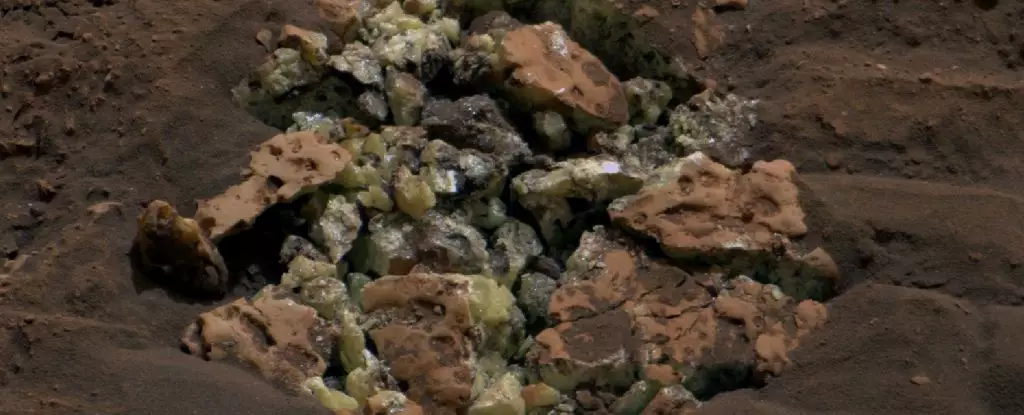In a remarkable twist of fate, NASA’s Curiosity rover unearthed an astonishing discovery on Mars when it accidentally cracked open a seemingly ordinary rock, revealing vibrant yellow crystals of pure sulfur. This event took place in May when the rover, whose considerable weight of 899 kilograms (1,982 pounds) made it an unlikely harbinger of such surprises, rolled over the unassuming geological feature located in the Gediz Vallis Channel. The revelation of these elemental sulfur crystals—often referred to as brimstone—represents a pivotal moment in Martian exploration, as it’s the first observed instance of sulfur in its uncombined state on the planet.
The Geological Significance of Sulfur on Mars
While sulfates, the salts formed when sulfur reacts with other minerals in the presence of water, are not uncommon on the Martian surface, the discovery of sulfur in its pure form opens new avenues for exploration and understanding. To contextualize, sulfates form when water evaporates, leaving behind an amalgamation of minerals that provide clues to the planet’s hydrological and geological past. However, pure sulfur emerges under a very specific set of conditions that scientists have yet to fully understand in relation to the region Curiosity explored. The implication here is clear: a field of rocks composed of pure sulfur challenges previous notions and begs an explanation.
Project scientist Ashwin Vasavada eloquently likened the discovery of these sulfurous formations to “finding an oasis in the desert.” It highlights a paradox in Mars’ environment. The Gediz Vallis Channel, once an ancient riverbed, suggests that water was a prevalent force in shaping the Martian landscape. The fact that pure sulfur exists in such proximity raises critical questions regarding the planet’s climatic and environmental history. How did the sulfur come to be in this form, and what conditions allowed for its preservation?
Examining the role of sulfur in life is equally crucial. As a building block for amino acids, sulfur has a longstanding connection to the biochemical processes required for life, though no direct evidence of life has yet been found on Mars. The presence of elemental sulfur and sulfates points to the potential for past habitable conditions, which is vitally important in the ongoing search for extraterrestrial life.
At present, the Curiosity rover continues its mission in the Gediz Vallis Channel, analyzing geological formations and collecting data to help unravel the complexities of Mars’ past. It has already drilled into a rock to obtain powder samples for chemical analysis. As Curiosity meticulously navigates through this ancient waterway, scientists eagerly await the insights each new discovery will provide regarding the mystery of sulfur and its implications for the history of water on Mars.
Moreover, understanding the origin of pure sulfur on Mars will likely require advanced modeling of the planet’s geological evolution. This research is not just about piecing together Mars’ history, but it also serves as a crucial step in the broader pursuit of knowledge about the potential for life beyond Earth. The interplay of chemistry, geology, and possible biotic processes is what makes planetary exploration so thrilling; every new finding builds upon the last, creating a more intricate picture of Mars.
The unearthing of pure sulfur crystals by the Curiosity rover marks a significant milestone in Mars exploration. This discovery not only raises important questions about Mars’s geological past but also ignites curiosity about the processes that formed these unusual deposits. As the Curiosity rover continues its journey through the Gediz Vallis Channel, scientists are positioned on the edge of new discoveries that could deepen our understanding of Mars and its potential for harboring life. The thrill of planetary exploration lies in its ability to consistently challenge our assumptions and inform our understanding of life, both on Mars and elsewhere in the cosmos.


Leave a Reply